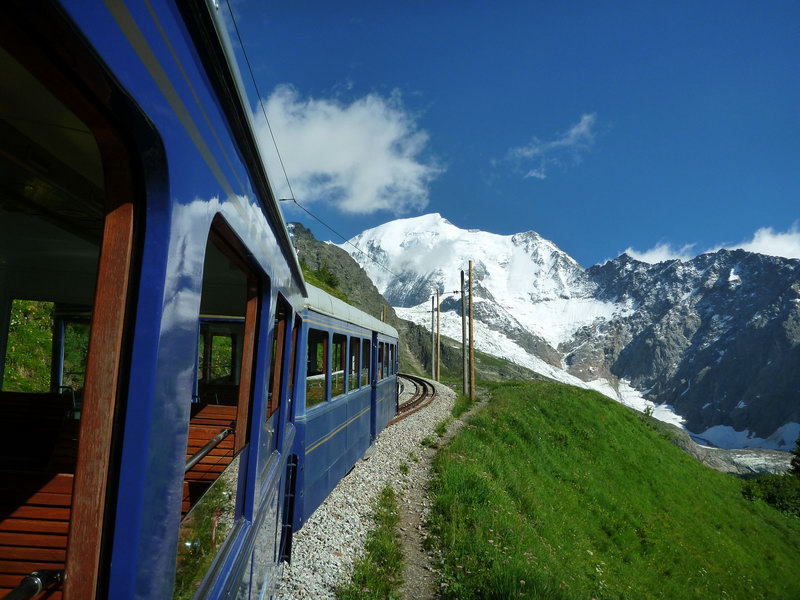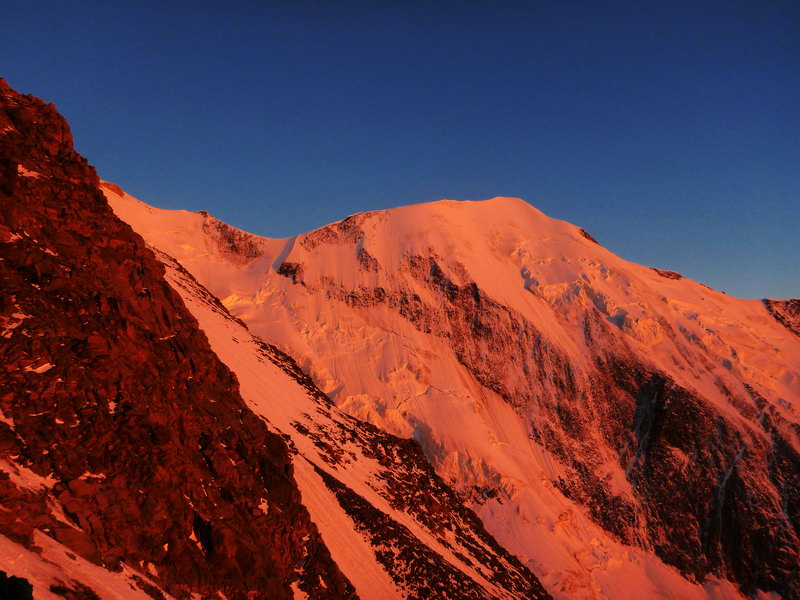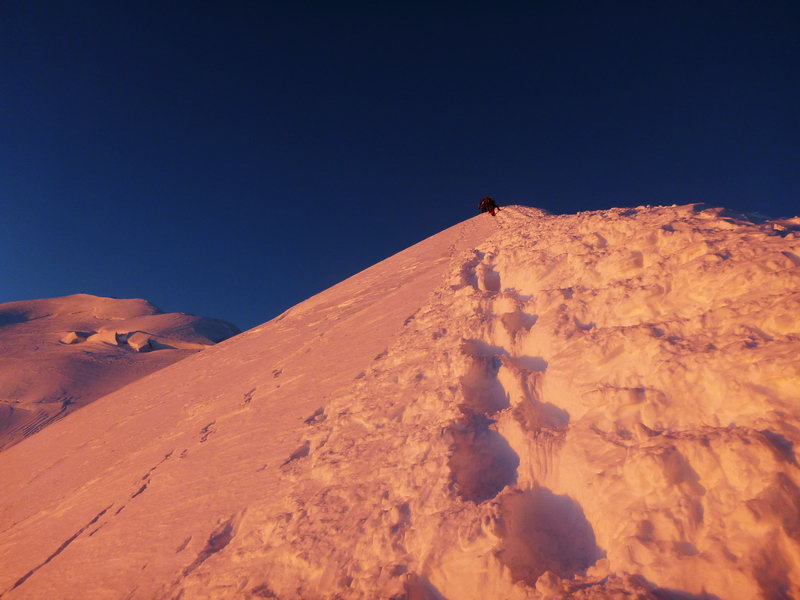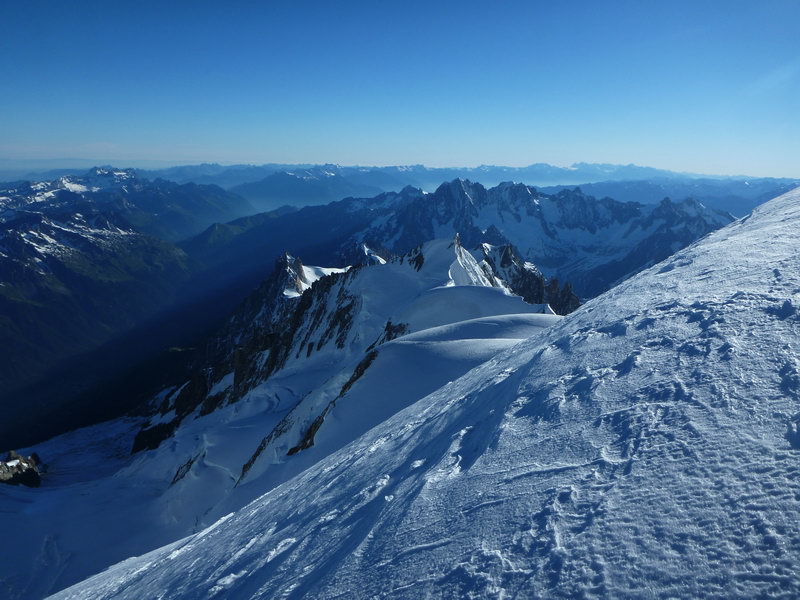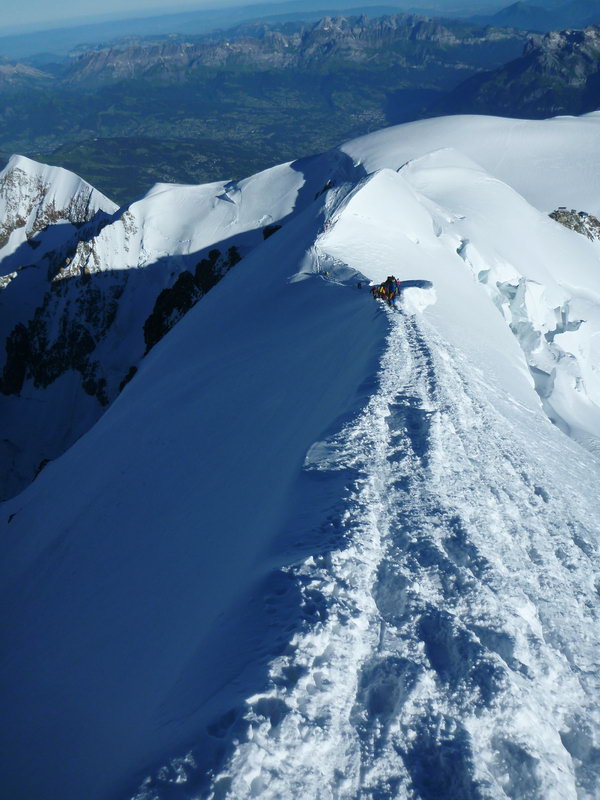Initially, the ascent of Mont Blanc was planned not along the classic route through the Tete Rousse and Goutera shelters, but along the route from the Refuge des Cosmiques through the three peaks of Mont Blanc - Mont Blanc du Tacul, Mont Maudit, Mont Blanc.
But a few days before the ascent, a cyclone came and a lot of fresh snow fell. Because of this, the slopes of Mont Blanc du Tacul became avalanche-prone and we decided not to take any chances…
There were still two days left before leaving Chamonix, and in order not to lose the opportunity to go to Mont Blanc, I decided to try to make an express ascent along the classic route. Looking ahead, I will say that I succeeded, the whole journey from Chamonix to the top of Mont Blanc and back took less than a day, but first things first.
In order to catch the last Tramway du Mont Blanc tram ride, Olya and I left Chamonix by bus to Les Houches village around 5 p.m. Then we took a cable car to the Bellevue tram station. Then I'll go alone, because the cable car finishes work at 6 o'clock, and Ole needs to get back in time so as not to go down to the village on foot.
I was the only passenger on the tram, no one even checked my ticket. First, the rails go through the forest, and then the tram leaves for the rocky slopes of the Mont Blanc massif, from where there is a great view of the peak covered with ice and snow.
At the terminal station of the tram, I met a mature mountain goat with huge horns, considered it a good sign (that he did not gore me) and at 18.30 began the ascent to the hut of Tete Rousse. I followed the trail that runs along the Bionassay glacier.
Not to say that the trail was very well found. It has a lot of branches on the moraine, which diverge and converge.
I was already beginning to doubt whether I was going there - there was no one around, the path was kind of weak, although according to my ideas there should be a trampled autobahn, because every day at least a hundred people pass...
But then the trail goes out onto the snowfield and the path is clearly visible. On the rise, I met a couple of Italians who came from Italy after crossing the ridge.
By about 8.30 pm I got to the Tete Rousse shelter. I took a break for 5 minutes, drank a mug of tea from a thermos and went on. The sun was still quite high and I kept walking until I could see something.
Immediately after the shelter, Tete Rousse passed through the tent camp and met our Swiss friend there, they planned to go climbing at 12 at night.
After the camp, you need to walk a little along the glacier, from which the snow ascent begins to the beginning of the rocky ridge. Immediately after this place, you need to go through the most dangerous place of the Grand Couloir route. It is located on the western slope and just the setting sun illuminates it best. And this means that the danger of rockfall is the highest. In general, I chose the most unfortunate time to cross this dangerous place.
While I was dressing the crampons, hiding behind a stone before going out into the lobby, several cobblestones of impressive size whistled past. Choosing a moment, I began to walk through the lobby, constantly looking up to see if anything was flying there. In the center of the couloir there was an unexpected obstacle in the form of a stream with banks of snow porridge and ice.
Diving into everything with this one foot and getting my shoe wet, I moved to the other side and without incident reached a safe place on the opposite side of the couloir.
While I was filming the crampons, several cobblestones again whistled along the lobby and disappeared into the cliff below. Somewhere I heard information that every year at least ten people get various injuries in this place.
Then the trail goes along the placers of huge stones and winds along the crest of the ridge going steeply up. There was no one else on the route at that time and no one bothered to admire the colors of the setting sun. The weather was great, there was not even a wind.
I managed to walk almost the entire ridge at dusk, and only the last part of the snow had to be walked in complete darkness. By 11 o'clock in the evening, I went up to Guter's hut.
Since I don't really like walking in the mountains at night - it's too cold, I decided to wait in Guter's hut and go climbing at dawn. But at 11 p.m., I no longer found any of the staff, although the light in the dining room was on, but it was empty and quiet. So I just decided to sit on the ground floor in the locker room, it was relatively warm (above zero) and there was no wind - what else do you need when you are without a tent? It was boring to sit, so I gradually lay down on the bench and even slept for a couple of hours until the first climbers began rattling their gear at 2 a.m. And why are they going there so early?
In general, after taking a nap for a couple more hours under the clang of carbines and the clanking of crampons, I realized that this would never end and also decided to pack up. I had a leisurely snack and drank tea and went out at 4 a.m. sharp. I immediately put on a cat, a down jacket, warm mittens, in general, everything that was to the maximum. Well, the headlamp is also there, still a whole hour before dawn. Although I really dislike early exits before dawn, it was impossible to sleep further, and it was boring to just sit there.
There were a lot of people, the whole path ahead was clearly visible thanks to the points of the climbers' lanterns. While walking in the dark, the road was not remembered in any way - in a small bright spot of the lantern, only the prints of crampons in the snow are visible and periodically you catch up with someone and overtake - that's it.
By dawn, I reached the ridge where the Vallo rescue hut is located at an altitude of 4,300 meters. Some unconscious people use it for a planned overnight stay in order to gain some altitude the night before and to climb the height difference was less. That's why the hut is littered, and the smell there is not very pleasant.
At least then you could look around and admire the dawn landscapes.
The most interesting part of the route begins from this place - the trail goes along a narrow ridge with cliffs on both sides.
There was a strong wind on the ridge, and in general it was quite cold - icicles grew on his mustache and beard from breathing.
Constantly taking breaks to take pictures, I slowly climbed the mountain. People began to meet already going down, I think most of them did not reach the top - it was too early to have time to return. Well, or were they those who left the Hutera shelter at two o'clock in the morning- but then what is the point of the whole ascent if the whole way up and the summit itself were in the dark?
These are the picturesque snow puffs encountered on the way up:
And now, behind another bend, a new snow dome appeared, which turned out to be the top. The clock showed 7 a.m., not bad for the first time.

The top of Mont Blanc is a wide snowy ridge that continues the path of ascent. There are no monuments, Lenin's heads and other debris on the top, there is not even anything to take a picture with ... But there is a great 360-degree view.

Just while I was at the top, a bunch of three people climbed the route "Through the three peaks of Mont Blanc" from the Kosmic shelter - they started at 2 a.m. it took them 5 hours to climb. So there are people who dared to go despite the avalanche danger.
After taking a couple more photos, I went downstairs. As with any other peak, there is not much to do here. Why did you lock yourself in here…
The descent follows the path of ascent, along the same snowy ridge, then through the Vallo hut along the glacier to the hut of Goutera. By 10 o'clock in the morning I went down to the Hutera shelter.
On the way down, I already took off my down jacket and warm mittens, as the sun was warming well, and the wind below the ridge was not very strong.
After taking a break in Guter's dressing room for about 15 minutes, I went downstairs. By this time, my tea from the thermos had already run out and I was terribly thirsty, but the toad did not allow me to pay 7 euros for a bottle of water. A liter of tea for the entire ascent is not enough, and there is absolutely nowhere to get water. Although no, there was one place - a stream in the middle of the Grand Couloir, but to collect water under the shelling of stones - some other time...
A snow ridge on the approach to the hut of Goutera on the way from the hut of Vallo.
There was a full house on the descent from the Hutera shelter to Tete Rousse, a lot of people went down and a lot went up. And the path is narrow. I realized how lucky I was last night when I was walking absolutely alone. On a narrow path among rocks, outrunning someone is a whole problem, and there is also a risk that someone will push a stone on your head, or you will someone... For some reason, almost everyone went down this rocky path in crampons, some even in bundles, although the stones were completely dry, without even a hint of ice or even snow. This greatly slows down the descent and it is quite difficult to overtake such a caravan, which is barely crawling down the rocks with the screech of metal crampons.
There is also a traffic jam in the Grand Couloir - there is only one path, and people are coming from both sides, at least they let pass oncoming people and do not have to warm up with someone right on the sidelines. One of the two men who passed in front of me was almost hit by a stone, he managed to take a step back and the stone hit exactly where he was standing a second ago. So it is just as unsafe to pass the Grand Couloir in the morning as in the evening. The only plus was that the stream in the middle of kulaur was much smaller and it was possible to cross it without any problems.
Without incident, I went down to the Tete Rousse shelter, from where I continued my descent not through the snow, but along a rocky path down to the tram station. The descent is very long and tedious, and the sun was shining from above. But there are many wild goats grazing on the rocky ruins of the moraines, which are almost not afraid of people and you can approach them literally 20 steps away.
I felt fatigue in my legs already at the Tete Rousse shelter, and while I was going down to the tram, my legs just started to "fall off".
In general, by one o'clock in the afternoon, I finally got to the tram station, where an unpleasant surprise awaited me. I thought I was finally going to get on the tram and go downstairs, but it turned out that the next tram would be in two hours… My legs were already buzzing by this time, but I decided that it would be better to walk to Bellevue station myself in 40 minutes than to wait for a tram for two hours. And so he did.
I took the lift down to Les Houches and took the bus to Chamonix. And by four o'clock in the afternoon I was already in Chamonix. So the whole ascent took less than a day, or rather 23 hours, of which I spent 5 hours at the Hutera shelter.
The walking part of the route began at an altitude of 2,372 meters, the height difference to the top of Mont Blanc (4,809 m) was 2,437 meters. Well, it's the same amount down, even more if you consider that I went all the way down to Bellevue.
A more detailed description of the Mont Blanc climbing route can be found in this article.
Independent ascent of Mont Blanc, route description
There is a constant debate among climbers about which mountain should be considered the highest point in Europe - Elbrus or Mont Blanc. But having visited both peaks, I can say that the route of cl...

